When walking around Japan you might see a small rectangular piece of paper pasted near a front door or on a gate. On this paper is an image that can only be described as a demon or devil. While off-putting at first, this creepy little fellow isn’t actually a bad guy; he’s there to protect the family and household. On this episode of Uncanny Japan, I’m going to tell you why.
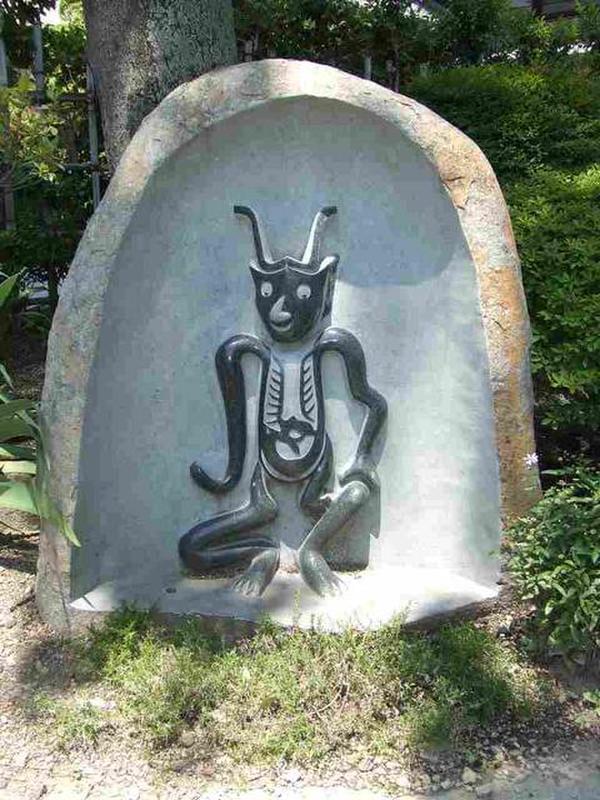
Hey, hey everyone. How are you all doing? I’m nursing a slight cold so my voice might be a little wonky. But I wanted to go ahead and record this and get it up because my plan is to get two episodes out in November.
It’s been a while since I’ve been to the ocean. So here I am. They’re mellow waves but I’m going to put just the binaurally-miked version of them up on my Patreon page for those who have trouble sleeping like me or just want to close their eyes and imagine sitting by a rocky Japanese shore.
Okay, on to today’s show. Today I’m going to tell you about Tsuno Daishi or the Great Horned Master. But before we get to him, let me explain what omamori and ofuda are.
What is an Omamori?
Mamoru is the verb to protect. So an omamori is a small amulet, often made from colorful brocaded silk with a string so you can tie it to things. Its purpose is to protect you or to help you in some area of your life. If you’ve been to Japan, I’m sure you’ve seen them. They’re sold in temples and shrines all over. They only cost a few hundred yen and are basically good luck charms that have specific uses. There are omamori to help you study, to keep you safe while driving, to help you become pregnant and then have a healthy baby, as well as ones to find the perfect lover or to come into a lot of money. You can see them dangling from people’s purses, backpacks, rear-view mirrors, or maybe even tucked inside a pencil case. So an omamori is a small, pretty, portable good luck charm.
What is an Ofuda?
There is also something called an ofuda. It too is a kind of talisman to ward off evil. But instead of being carried around, it’s hung or pasted somewhere, usually a house, front gate, or a store. They can be made of wood, cloth, or metal, but I think the kind I see most often are paper strips with fancy characters on them and stamped with red vermillion hanko.
If you visit a temple or a shrine in Japan, pay attention to the front gate, the pillars, and the ceilings. Sometimes you can see old ofuda plastered willy-nilly all over the place. I think they’re super cool, and they’re believed to prevent evil spirits from entering one’s abode.
You’ll also find ofuda mentioned in all kinds of Japanese tales. For example, I just wrote an article for Sotheby’s about the great three Japanese ghosts. And one of the stories, called Botan Dōrō, is about Otsuyu. I don’t want to give away too much, but at one point an ofuda is used to keep the ghost out of our protagonist’s house.
So that’s an omamori which segues into an ofuda, which segues into today’s topic. Let me tell you about Tsuno Daishi.
The Story of Tsuno Daishi
The first time I came across the Great Horned Master, or the Tsuno Daishi, was about 15 years ago, when I visited a tiny mountain village in my town called Hanazawa no Sato. It’s this quiet neighborhood with 100-year-old homes, narrow roads, mossy stone walls, and trickling streams. As I walked along and admired the architecture, I noticed that almost every house had a very disturbing ofuda pasted on their doors or on their wooden gates. To me, it looked like a demon. The more I walked, the more unsettled I became. Was it some strange religious cult? Let me try to describe what I saw.
Okay, imagine an ofuda, a rectangular piece of white paper, I don’t know, about 20 centimeters or 8 inches long by 10 centimeters or 4 inches wide. On it is printed a simple black image. It’s a figure kind of sitting or crouching down on its haunches. There are thin, boneless-looking wavy arms and legs. A body that is black, except for what looks like cut out white parts that could represent ribs and a couple internal organs, the stomach and kidneys, maybe. The creature has round buggy eyes, a big nose, and horns, or could they be antlers?
Recently, a Japanese friend said that from a distance, it looks like a character from Sanskrit, and she’s spot on. It’s got that vibe. I mean, the Tsuno Daishi is very old, and I suppose there is a possibility that he traveled all the way from India. But here are the stories I’ve read about the origins of this creepy little guy.
Once upon a time, there was a monk named Ryōgen. He was born in 912 and became the 18th abbot of the Enryaku Temple in the year 966. He spent the next 19 years rebuilding the temple complex and upping the image of the Tendai sect of Buddhism. One day, I’ll touch upon some of the different types of Buddhism in Japan. But for now, just know that Tendai is not Zen. It, along with the Shingon sect, is an esoteric or Mikkyō school. Think tantra, wonderful rituals that involve gorgeous Indian objects, and lots and lots of fire. OK, back to Ryōgen. At one point, the emperor Enyu was very ill, and Ryōgen prayed for his health. The emperor then did indeed recover, and Ryōgen was granted the title Daishi, or great master.
There are a couple versions of how he became associated with the horned devil-looking fellow I saw on the houses. The first one just says that he gained the curious supernatural ability of being able to transform his body into that of a demon.
One day, when the town was hit by a deadly epidemic, and people were dying left and right, Ryōgen turned himself into this horned creature and frightened the plague god, or Yakubyougami, away.
A second story that I’ve heard from people in Japan but have not found written in English anywhere is an elaboration on the story above. Again, it starts with a horrible epidemic plaguing the city, and Ryōgen, in order to try to save the people, decides to sit in front of a full-length mirror and meditate. While meditating, one of his followers sketched a picture of what he saw in the mirror. Slowly, the reflection of the stoic abbot Ryōgen changed. The flesh fell away, and he was revealed as a hideous demon or oni. The follower later copied this image by carving a woodblock print and making a fuda for people to put outside their homes to keep away illness.
Ryōgen is believed to have said something about, the best way to fight off a scary demon is to become a scarier demon. So the image of the Tsuno Daishi is one that can ward off evil and illness.
A real quick note about names, while the abbot was called Ryōgen Daishi while alive, he acquired quite a few monikers after his death. The first one being his posthumous name. When people die in Japan, even now, they are given a new name for the afterlife. Ryōgen was given Jie, so Jie Daishi was one of his names.
But then there are cooler names like Tsuno Daishi, the great horned master, and Ganzan Daishi, the third day of the first month master, because that was the day he died.
You’ll also find him sometimes referred to as the Mayoke Daishi or Gooma Daishi, great master of warding off evil. I’ve seen one English translation that calls him simply the demon king, and I kind of like that too.
Another interesting thing I’ve read is that there are 18 icons of Tsuno Daishi, and all of them are enshrined in different temples scattered throughout Kyoto. On January 3rd, the day he died, a small group of devoted followers attempts to pay a visit to each and every one of these 18 temples.
Oh, and here’s a cute legend about him. There was a statue of Tsuno Daishi in a temple called Jindai-ji. During the Muromachi era, there was a great fire that destroyed the temple. Only later it was learned that the statue had survived because it flew and hid inside a nearby pond.
So when in Japan, keep a lookout for the creepy little demon king on fuda high up on a front door or gate, and tell your friend who you’re traveling with that he’s not a bad guy. He’s actually a good guy, keeping someone safe from evil and the plague.
After that first experience, I started seeing him everywhere, tucked under eaves or faded on the tall wooden front gate of a house. Then one day I was visiting a temple deep in the mountains, and I saw that they sold the ofudas. Not big ones like I described, but small, business card-sized ones. Gold and green laminated paper. So I bought one. It’s meant to be kept in your wallet, a kind of omamori-fuda hybrid maybe? I’ll put some images on the Uncanny Japan website so you can see what he looks like.
And I found a really cute version of the Tsuno Daishi that I’m going to use for postcards this month for my patrons. And speaking of patrons, I want to extra especially thank all of you. Life is quite tumultuous right now, and if it weren’t for you all, I’m not sure what would happen to this show. So thank you so much.
And be sure to go to the Patreon page so you can get some binaurally-miked ocean waves this month. And on top of that, I wanted to mention here that I also got some more stickers, round ones that have the ojizo oni logo from the podcast, the one with the red background. They’re quite stunning, and if you’re a patron and you want one, please let me know, and I can get that out to you while supplies last.
Thank you all so much for listening, supporting, reviewing. I had some really good reviews this past week. Messaging, emailing, and spreading the word about Uncanny Japan. I will talk to you all again real soon.
Credits
Intro and outro music by Julyan Ray Matsuura

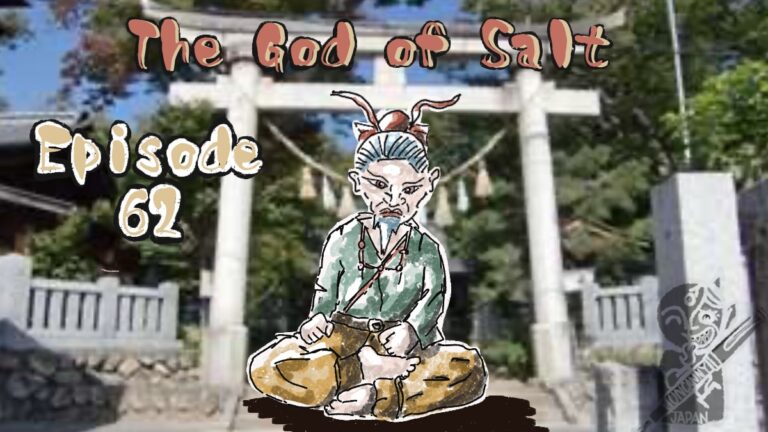
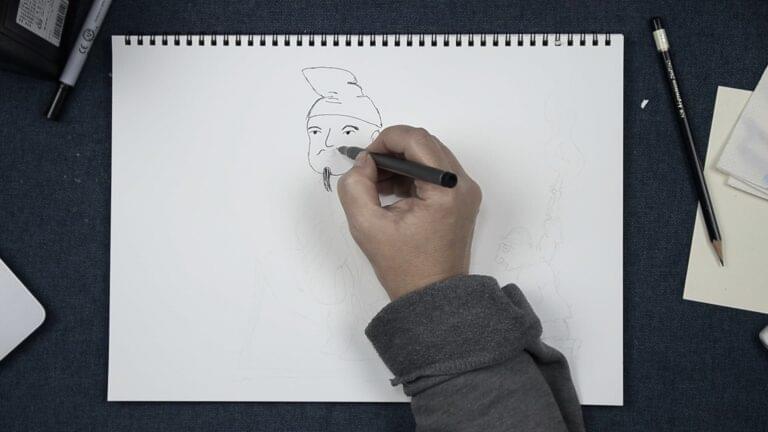
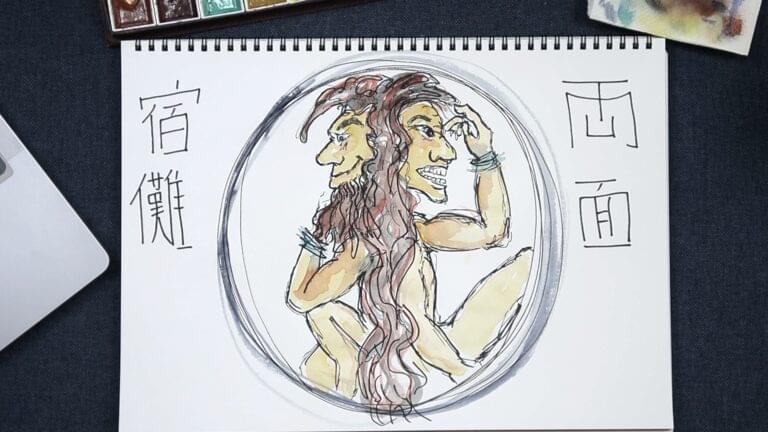
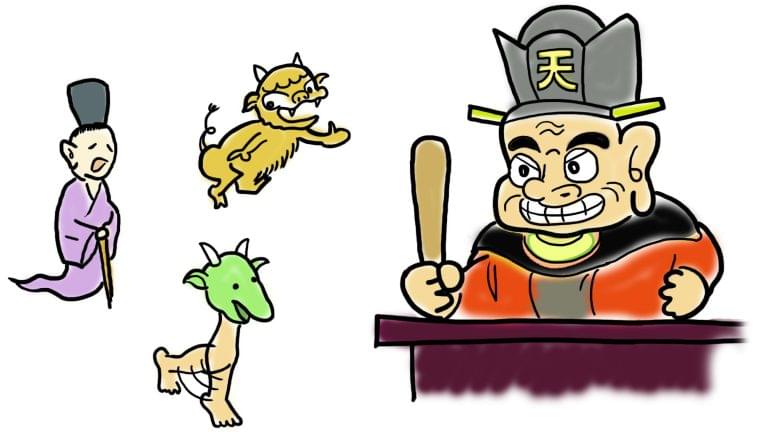


What a fascinating story. Perhaps we all need one of these little demons to protect us and our loved ones during the Corona Virus lockdown.
Kind regards Jack Sims Chidokan New Zealand.
Indeed, I’ve always been drawn to him and all he wants is for us to be healthy. Thank you for checking out the show. ^^d
I always think about Yahweh and his son Abaddon. They’re much scarier – especially to demons! They will soon bring an end to sickness, wickedness and death.
Very cool!I will look up the stories there.
The Tsuno Daishi (角大師, “Horned Great Master”) is the first tattoo I received when I turned 18yo (circa 1995).
It was pointed out to me that he is holding his own severed leg which is not intuitively obvious until pointed out. It must be a central element and core of its meaning , but I have struggled to understand what exactly. Any ideas?
That is the coolest first tattoo I’ve ever heard of. I did NOT know about the severed leg. I’m going to do some digging and ask around. I do have a Japanese friend who is really into Tsuno Daishi. I’ll start with him and get back to you.
I got the same tattoo in the early 90’s. What’s funny is that I had no idea what it really was when I got it. I found it as a piece of clip art imbedded on one of the many pages of Ivan Stangs “church of the sun genius” book. So I get this tattoo on my back just because I liked it. Then years later at a “Hoonenany” outdoor festival put on by the band Social Distortion annually ( long time ago) I’m out there and dogged a limo that had Jerry Lee Lewis in it that drive through the crowd, he played great ball’s of fire, anyway some girl behind me says “ is that a chupa cobre on your back? “. Of course I said I don’t know. She laughs and says you got a goat sucker in your back. So for decades that’s what I thought it was, imagine the shame. Then fast forward to Google and the ability to search for images, then imagine my surprise around the COVID outbreak when I find this website and see that actually a tsuno dashi, I was happy to read the remarkable story and even happier that at a young age I managed to ward off sickness and demons for the majority of my adult life. So the reason I wanted to comment, the floating leg thing. I have that on mine from a clip art print, but as you can see from the statue the leg is in tact, it leaves me wondering if the floating leg originated from a printing press? Curious about that also.
That is the most amazing story, Sean. I absolutely love it. Good catch on the floating leg. That would make sense. I think the “uncanniness” and possible meanings of floating leg makes people want to imagine some other meaning. Stay safe and well! Your Tsuno Daishi is taking care of you ╰(*´︶`*)╯♡
Creo que fue en 1994 que me hice ese mismo tatuaje, en mi escápula izquierda, también lo saqué del mismo libro que mencionaste, aún los tengo, pero ahora recién me entero del significado de mi tatuaje, a mi me decían que era una hormiga jaja
“I think it was in 1994 that I got that same tattoo, on my left shoulder blade. I even got it from the same book you mentioned. I still have them, but I just found out the meaning of my tattoo. People used to tell me it was an ant, haha.”
Qué maravilloso que tengas el mismo tatuaje de la suerte (¿pero de aspecto aterrador? ¿Parecido a una hormiga?) del mismo libro. ¡Que Tsunodaishi te proteja!
Just stumbled across this episode after trying to get more information on the images I saw in some temples in Japan.
In Nikko, I believe it was the Rin’nōji Temple, they had more information on this story in English, but searching keywords from that story didn’t turn up much. The story listed there is similar to the one with the mirror, with some extra details. In that story, the first interaction was before the mirror in a plague ridden area, where the demon said he would infect Ryogen, who then showed the demon his little finger (some details escape me as no photos in the temple). After this he did the mediation session with the mirror, where all his disciples fainted at what they saw in the mirror, but except for one who used ink to draw what he saw in the mirror. This was said to be the origin of the image that is used to ward off plague- very similar to the story above, but with a few extra details. I wish I’d managed to remember every part of the story, but it was only when seeing the print for sale at another temple I started to be more interested.
Jim, I am absolutely charmed and infatuated with Tsuno Daishi. I find it really, really interesting, too, how little details change from areas to area, temple to temple. Well, I guess that applies to most legends and folktales, myth and history even. I love that you noticed the image and were able to find more information about him. I haven’t been to Nikko since university, but now I want to go to compare stores. Thank you so much for sharing this 😀🙏
Lovely to read more about it. Do you have a list of all the 18 temples around kyoto? We’ve visited a few if them, but would love to know where to find the others.
Thank you
Oh, I’d have to look them up. But that is a very worthy goal. ✨🙌